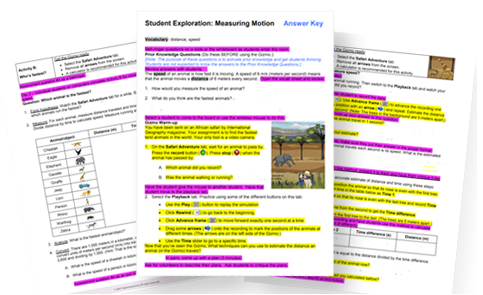
Easy Lesson Planning with Gizmos Materials
When conducting whole-group lessons with students, you can use Gizmos Student Exploration Sheets to guide the lesson path and your questioning with students.But you may wonder, should I print out those sheets for my students, or do something else?
 像往常一样,你将想要教训objectives to make that decision. If you are using the whole group Gizmo lesson to engage your students and get them to begin thinking about a concept, it may not be necessary for them to have a document to write on. On the other hand, if you are using the Gizmo later in your lesson to build understanding, having a document to guide them might be very beneficial.
像往常一样,你将想要教训objectives to make that decision. If you are using the whole group Gizmo lesson to engage your students and get them to begin thinking about a concept, it may not be necessary for them to have a document to write on. On the other hand, if you are using the Gizmo later in your lesson to build understanding, having a document to guide them might be very beneficial.
Keep in mind that you don’t need to use the entire Student Exploration Sheet “as-is.” You can pick just one activity and modify the Word document to meet your needs. You can also create entirely new documents by using the snapshot feature in each Gizmo to embed pictures, graphs and data into your documents. A quick question around a picture can be a great formative assessment to be used before, during or after a lesson in your sequence.
Other ideas for student documents that can support whole class instruction:
Before the lesson:
- Prior Knowledge questions from the Student Exploration Sheets can be handed out as bell-ringers as students enter class.
During the lesson:
- Create an outline of the lesson on which students can take notes. As you proceed through your planned whole-group lesson, what do you want students to notice? What conclusions would you like them to draw? Create a student document to scaffold questions and observations for the students so that they can achieve the objectives of your lesson.
- Provide data recording templates for individual analysis. If your whole-group lesson includes collecting data that will be reviewed to identify patterns, it will help students to have a document they can record the data on as you collect it as a group. Not only will the students be able to practice the skill of recording data accurately in a table or other appropriate format, they will have their own copy for the analysis exercises.
After the lesson:
- Create a follow-up activity that applies the concepts learned during the whole-group lesson. In the ExploreLearning PD Team, we love creating writing prompts for Gizmos that support the Common Core standards.
- Exit tickets. One of the questions from the Student Exploration Sheet may lend itself perfectly to a question for your students to answer before they leave class.
- Differentiated homework (with or without a computer.) By using snapshots of Gizmos and data, you can create homework where students can practice the skills learned in the whole-group lesson without the need for a computer. Or, for students that have computer access at home, give them a second option so that they can use the Gizmos at home.
If you’ve already created interesting lessons around a Gizmo, please help out your colleagues by sharing your lesson materials of the Gizmo. Select “contribute lesson materials” under the Gizmo to share.
Beyond Whole Group Instruction
Instruction with Gizmos goes beyond a whole-group approach in a classroom, however. With access to at least one computer or iPad per three to four students, the possibilities open up even more. Students can work in small collaborative groups to completeStudent Exploration Sheet activitiesor to find solutions to teacher challenges. With enough devices for each student to work individually with Gizmos, instruction can be differentiated even further. Students can work on different activities with the same Gizmo, or work across multiple Gizmos to explore different aspects of the target concept.
Even when technology is available for all your students to explore a concept with Gizmos individually, they will benefit greatly from a whole-group introduction to the Gizmo and discussion of the goals of the lesson. A great way to ensure that your students are ready to succeed at the start of class is to pose the Prior Knowledge Questions (in the Exploration Sheet) as bell-ringers back in the classroom, and then follow up with a whole-class activity that goes through the controls of the Gizmo and the Gizmo Warm-Up.
在学生完成各自的活性ities with the Gizmo, be sure to conduct a follow-up activity in a whole-group setting. This follow-up gives students an opportunity to process their learning and you an opportunity to informally assess student understanding. All of the best practices in whole-group instruction in this article series are equally applicable regardless of student device access.
Start using math and science simulations in your classroom
Math and science Gizmos are great for whole group, small group or individual instruction. Start using Gizmos in your classroom with a free account. Afree accountgives you access to 20-40 Gizmos from our library of over 450+ simulations.
Pass it on!